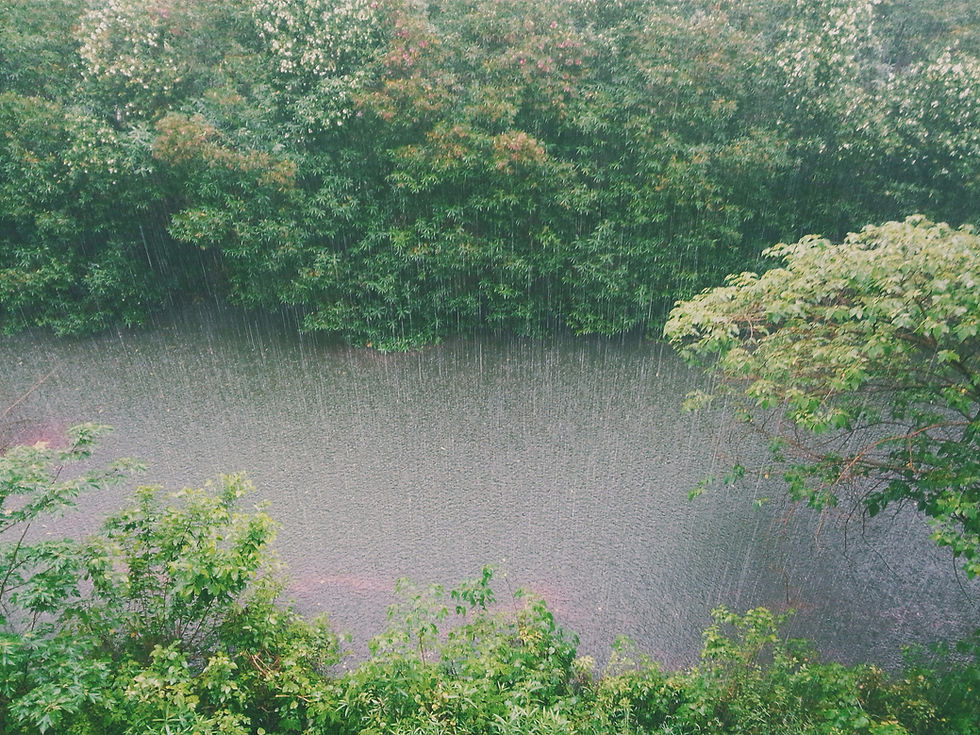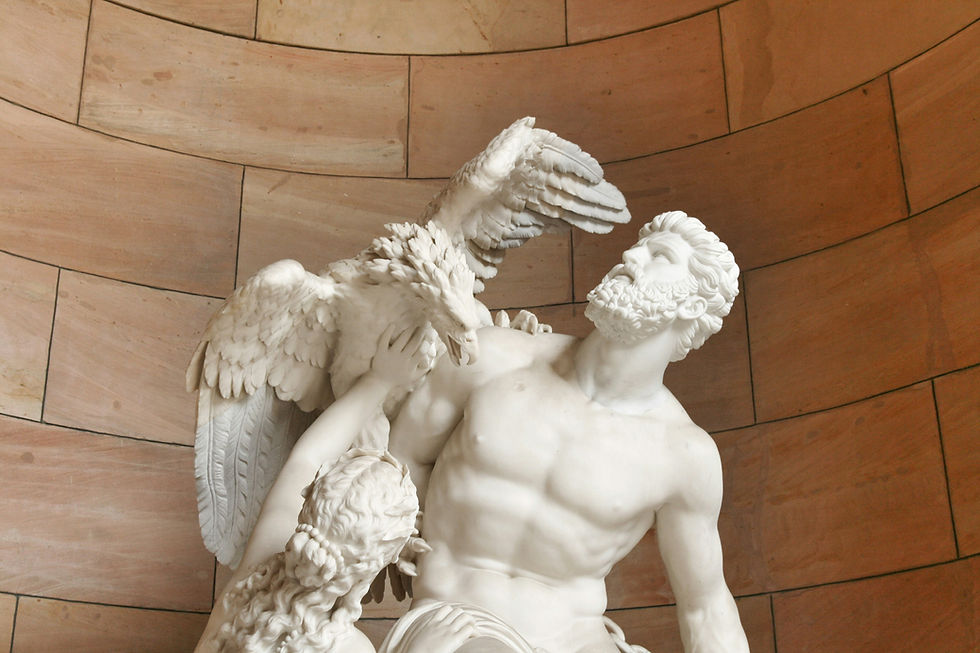Why Flood Myths Exist in Nearly Every Civilisation
- Marija Istrefi
- Sep 9
- 8 min read
From ancient clay tablets in Mesopotamia to the stories passed down by Indigenous peoples in the Americas, tale of a divine flood, a lone survivor, and humanity’s rebirth seems to resonate with everyone.
Why is it so common? Did a single, devastating event happen so long ago that it’s stuck in our minds? Or is there something deeper, a basic pattern in our consciousness that shows up in this story? The answer is a mix of shared human experiences, psychology, and our connection to the world.
A Compendium of Deluges
Flood myths, or deluge myths, are narratives in which a great flood, usually sent by a deity or deities, destroys civilisation, often as an act of divine retribution. The water is a primal, dualistic force: it destroys but also cleanses, preparing the world for a new beginning. And in nearly every tale, a culture hero manages to survive, ensuring the continuation of life.
The Mesopotamian Epic of Atra-Hasis and Gilgamesh, the oldest known narrative of a divinely-initiated flood, originates from Sumerian culture. In the Akkadian epic of Atra-Hasis, the gods, growing weary of the noisy humans they created, decide to wipe them out with a flood. However, the rebellious god Enki secretly warns his priest, Atra-hasis, providing him with precise instructions to build a boat and save his family and animals. This tale shares a profound parallel with the more famous Epic of Gilgamesh, where the flood is survived by a man named Utnapishtim, who is granted immortality for his piety.
The Hebrew Genesis Narrative, a tale familiar to many in the Western world, recounts the story of God Yahweh’s decision to flood the earth due to humanity’s corruption and wickedness. To save humanity, Yahweh instructs the righteous man, Noah, to construct a massive ark and gather his family and a pair of every animal. When the destructive waters recede, all on board disembark, and Yahweh promises never to flood the earth again, symbolising this promise with a rainbow.
Hindu texts like the Satapatha Brahmana and the Puranas speak of a great flood that is part of a bigger cosmic cycle. The story goes that the Matsya Avatar of the god Vishnu warns Manu, the first man, about the flood. Matsya tells Manu to build a huge boat, and when the flood comes, he takes Manu’s boat to safety, making sure humanity is reborn.
Greek Mythology recounts the story of Deucalion, as narrated in Plato’s Timaeus. Zeus, the high god, punishes the “Bronze race” of humans for their incessant warring. Titan Prometheus warns his son Deucalion of Zeus’s plan. He instructs Deucalion to build an ark. After nine days and nights, the waters recede, and the ark lands on Mount Parnassus. From there, Deucalion and his wife Pyrrha repopulate the world by throwing stones over their shoulders.
Norse Mythology is a stark contrast to other mythologies, characterised by a flood of blood. When Odin and his brothers Vili and Ve kill the frost giant Ymir, the blood that gushes from his body floods the earth, drowning all the other frost giants except for Bergelmir and his wife, who escape in a boat made from a hollowed-out tree trunk.
Chinese Mythology presents a unique narrative with the Great Flood of China. Unlike other flood stories, Yu the Great, the hero, doesn’t construct an ark to escape the catastrophe. Instead, he dedicates years to channeling and dredging the floodwaters. This remarkable feat showcases the triumph of human ingenuity and labor over the chaotic forces of nature. Yu’s actions bring order to the land, paving the way for the development of lowland agriculture.
North American Indigenous Traditions like the Cheyenne tribe has a tradition of a great flood that changed the course of their history. The Blackfeet, in their story "Language on a Mountain," speak of the deity Napi, or "Old Man," who describes a great flood that swept the land. The Hopi and other Puebloan peoples also have legends of a flood that reached the mountaintops. The Aztec myth tells of a man named Tata and his wife Nena who hollow out a cypress tree to survive a flood sent by the god Tezcatlipoca.
In a story from the Ifugao people (Philippines), the river gods become enraged and unleash a catastrophic flood that wipes out all of humanity except for two survivors, Wigan and Bugan. Once the waters recede, these two individuals embark on a journey to repopulate the earth.
Australian Aboriginal myths sometimes revolve around catastrophic water-based events. One such myth is that of Tiddalik, a massive frog who drank all the freshwater, forcing other animals to devise a plan to make him laugh and release the water.

The Human Need for a Deluge
The universality of these tales can be attributed to a powerful synthesis of two things: lived experience and shared human psychology. The myths aren't just stories; they are a form of collective memory and a blueprint for a shared human experience of cataclysm and renewal.
A Geomythological Explanation
First, let’s consider the most straightforward explanation: geomythology, the study of how geological events inspire myths. The great cradles of early civilisation, Mesopotamia, the Nile Valley, and the Indus River Basin, were all built on fertile floodplains. For these ancient peoples, floods were not mere metaphors; they were a terrifying annual reality. A massive “thousand-year flood” would have submerged their entire known world, a cataclysm of unimaginable scale. It is highly plausible that these local but catastrophic events were passed down through generations, becoming embellished and mythologised over time.
For instance, archaeological excavations at the site of Shuruppak in modern-day Iraq revealed a 60cm layer of alluvial sand and clay, a clear sign of a massive flood, dating to around 2900 BCE. This event could very well have been the inspiration for the local legends of Utanapishtim and his ark.
Beyond Mesopotamia, other geological events have been theorised as the basis for these myths.
The Black Sea Deluge, one of the most discussed hypotheses, proposes a catastrophic influx of water from the Mediterranean Sea into the Black Sea basin approximately 5600 BCE. At that time, the Black Sea was a much smaller, landlocked freshwater lake. As post-glacial sea levels rose, the Mediterranean is believed to have breached the Bosporus Strait, resulting in a massive, destructive flood that would have submerged coastal communities surrounding the lake. The sudden and violent nature of this event would undoubtedly have left an indelible mark on the memories of any survivors.
In 2016, a study uncovered geological evidence suggesting a massive landslide in China’s Jishi Gorge. This landslide, which occurred around 1920 BCE, would have sent an astonishing amount of water, over half a million cubic meters per second, down the Yellow River. This event is now believed to have inspired the Chinese flood myths, particularly the story of Yu the Great.
A more dramatic and highly debated theory, proposed by archaeologist Bruce Masse, suggests that an oceanic asteroid impact between Africa and Antarctica around 2807 BCE could have triggered a colossal tsunami that engulfed coastal regions. This event, allegedly linked to a solar eclipse, could have served as a singular, global occurrence to explain the widespread prevalence of myths.
The Toba Supervolcano, an eruption around 74,000 years ago, is hypothesised to have created a “volcanic winter” that could have reduced the human population to just a few thousand survivors, leading to a “genetic bottleneck.” While recent evidence has largely debunked the idea of a catastrophic die-off, the concept of a single, devastating natural event having a lasting impact on human survival and memory remains a powerful one.
A Psychological Explanation
Beyond geology, there's a powerful psychological reason for the universality of these myths. Water is a fundamental, deeply symbolic force in human life. It's the basis of all life, a source of sustenance, and a symbol of cleansing and purity. Yet, it is also a symbol of chaos, destruction, and the unknown. This duality makes it the perfect vehicle for a story about death and rebirth. This concept aligns with Carl Jung's idea of the "collective unconscious," a shared pattern of human thought that exists across all of humanity. The flood, in this sense, is an archetype; a universal symbol of the old world being destroyed to make way for a new, purer one. The flood isn't just a physical event; it's an allegory for the human experience of overcoming adversity and starting anew.
This psychological foundation is supported by the fact that many flood myths are interwoven with creation myths. The primordial waters of chaos from which the world is formed often return in the form of a flood to destroy it. In both scenarios, water is the medium through which order is established from disorder. The hero of the flood myth, the lone survivor, is a representation of the human craving for life and our ability to endure. They are the Adam and Eve of the post-deluge world, given a fresh slate and a divine mandate to repopulate. The narrative provides comfort and meaning in the face of random, terrifying natural events. It gives humanity a sense of agency, suggesting that by being righteous, clever, or divinely favoured, one can survive what appears to be an unstoppable force of nature.
So, was there a single, global flood event that inspired all these stories?
The No Case
From a modern scientific perspective, the concept of a single, universal flood covering the entire planet is highly improbable. The sheer logistical and physical challenges associated with such an event, including the source of the water, its disappearance, and the uniform distribution of species afterward, are inconsistent with the principles of geology, archaeology, and biology. The world’s mountains and geological strata do not exhibit evidence of a single, global flood event. Moreover, the myths themselves, while sharing a common structure, exhibit variations in their specific details and timelines, indicating that a singular, planetary event is unlikely to be the sole inspiration for all of them.
The Yes Case
However, this doesn't mean the myths aren't rooted in historical reality. Instead of a single global flood, it is entirely possible that multiple, localised but catastrophic floods occurred and became the basis for their respective myths. The power of oral tradition would have allowed these stories to travel and evolve, borrowing elements from other cultures and adapting to local geographies.
The myths are a form of geomythology, a way for ancient peoples to preserve the memory of a real natural disaster and to pass on crucial survival information to future generations. For those who experienced a flood of a scale that wiped out their entire known world, it would have felt like a global event. The memory of the flood wasn't just a story; it was a warning. The flood didn't happen by chance; it happened for a reason. And because it had a reason, often a moral one, a divine punishment, humanity could find a way to survive and move forward. The fact that these stories often vary in specific details, a giant's blood in the Norse myth, an asteroid impact in some recent theories, but share a core structure is what makes them so fascinating. It suggests that while the specifics of the events may have differed, or been entirely mythical, the human mind's need to create a narrative of cleansing and rebirth from a great flood is a shared, universal impulse.
So, while we may never know if a single, global flood ever occurred, the myths themselves are real. They are the living echoes of humanity's long, difficult journey, a testament to our enduring fascination with the power of water and our timeless hope for a new beginning.

